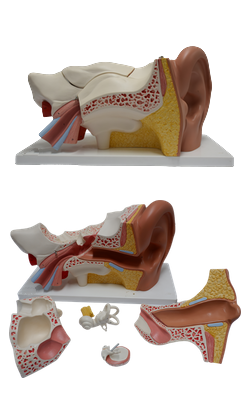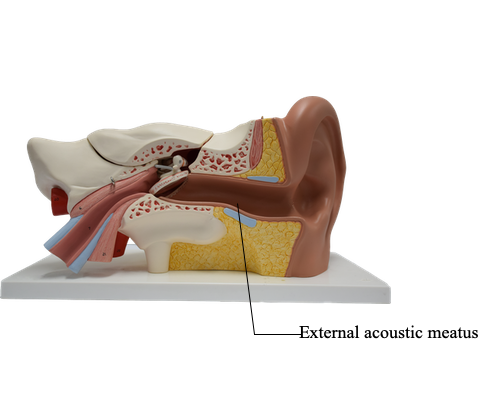Main Model

External ear : 2 External acoustic meatus

The external ear is composed of the shell-like auricle (pinna), which collects sound, and the external acoustic meatus (ear canal), which conducts sound to the tympanic membrane.
The external acoustic meatus is an ear canal that leads inward through the tympanic part of the temporal bone from the auricle to the tympanic membrane, a distance of 2-3 cm in adults. The lateral third of this slightly S-shaped canal is cartilaginous and is lined with skin that is continuous with the auricular skin. The medial two thirds of the meatus is bony and lined with thin skin that is continuous with the external layer of the tympanic membrane. The ceruminous and sebaceous glands in the subcutaneous tissue of the cartilaginous part of the meatus produce cerumen (earwax).
The tympanic membrane, approximately 1 cm in diameter, is a thin, oval semitransparent membrane at the medial end of the external acoustic meatus. This membrane forms a partition between the external acoustic meatus and the tympanic cavity of the middle ear. The tympanic membrane is covered with thin skin externally and mucous membrane of the middle ear internally. Viewed through an otoscope, the tympanic membrane has a concavity toward the external acoustic meatus with a shallow, cone-like central depression, the peak of which is the umbo. The central axis of the tympanic membrane passes perpendicularly through the umbo like the handle of an umbrella, running anteriorly and inferiorly as it runs laterally. Thus, the tympanic membrane is oriented like a mini radar or satellite dish positioned to receive signals coming from the ground in front and to the side of the head.
Superior to the lateral process of the malleus (one of the small ear bones, or auditory ossicles, of the middle ear), the membrane is thin and is called the pars flaccida (flaccid part). It lacks the radial and circular fibers present in the remainder of the membrane, called the pars tensa (tense part). The flaccid part forms the lateral wall of the superior recess of the tympanic cavity.
The tympanic membrane moves in response to air vibrations that pass to it through the external acoustic meatus. Movements of the membrane are transmitted by the auditory ossicles through the middle ear to the internal ear. The external surface of the tympanic membrane is supplied mainly by the auriculotemporal nerve, a branch of CN V3. Some innervation is supplied by a small auricular branch of the vagus (CN X). The internal surface of the tympanic membrane is supplied by the glossopharyngeal nerve (CN IX).